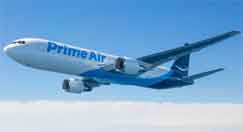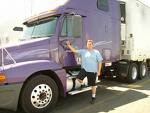| |
|
| |
|
 |
Supply
Chain by the Numbers |
| |
|
| |
- May 28, 2020 -
|
| |
|
| |
|
| |
|
| |
Amazon to Rapidly Expand Cargo Plane Fleet; Gap Stores Says Send DC Robots Faster; Virus Crisis might Accelerate Drone Usage; US Truck Driver Pay Up Sharply |
| |
|
| |
| |
| |
| |
200 |
 |
That's about how many cargo jets Amazon is likely to have by 2028, according to a new report from Joseph Schwieterman and Jacob Walls of the Chaddick Institute for Metropolitan Development. That as Amazon is not too far away from opening its air hub near Cincinnati, and the ecommerce giant is likely to expand its international flights. At the end of 2019, Amazon was estimated to have 39 cargo aircraft, meaning it would need to add 1.5 planes per month to get to 200 by 2020. "The completion of facilities at Cincinnati [which will reportedly have space for 100 aircraft] and expansion in international markets could result in growth for the next several years well above 20%," the report says. The report also found that the Amazon Air network now makes around 100 flights a day and is primarily designed to augment the services of DHL International, FedEx, and UPS by filling critical links between its fulfillment and sorting centers, rather than being designed to replace those carriers outright – for now. The authors say Amazon is also looking to reduce its reliance on those other carriers. At 200 planes, Amazon would still be well under the current fleet at FedEx, but put it about on par with UPS.
|
|
|
| |
| |
|
|
|
That is how many miles each way a drone flight traveled to drop of a box of protective masks Novant Health's Huntersville Medical Center near Charlotte. The flight, about 30 minutes round-trip, marked the first U.S. delivery for Zipline Inc., a California drone startup that has been transporting medical supplies in Rwanda and Ghana since 2016. Zipline says it marked the longest commercial drone delivery route in the country. The Zipline launch site now houses 10 drones, each capable of running dozens of trips per day up to a range of 100 miles round-trip. At full capacity, it should be able handle 30 drones. As SCDigest reported earlier this week, the virus crisis may turn out to be an inflection point that marks a new, fast growth era for drones, in applications ranging from police support to disinfecting city streets to, of course, deliveries. Wing, the drone-delivery service owned by Google's parent company Alphabet, has started commercial package delivery with drones in partnership with drug store retailer Walgreen's. Now, in the midst of the virus crisis, the drones are delivering not only medicines, but also items like toilet paper and groceries. The drone deliveries are especially popular with seniors staying indoors – and ser ves as an extreme outlier in which an older demographic that usually spurns new technology quickly jumped on board. |
| |
| |
|
| |
| |
$58,000 |
 |
That was the average pay made by US truck drivers in 2019, according to the just released Driver Compensation Study from the American Trucking Associations (ATA). The $58,000 number includes wages and any bonuses a driver may have received. That number is also up $6000, or 11%, since the ATA's previous study in 2017. The average reflects rates for truckload drivers. Even though it was a weak year for the US freight market in 2019, demand for drivers still exceeded supply, push pay rates higher. "These results show that fleets did exactly what we would expect them to in the face of a tightening market for drivers: they raised pay and increased benefits in order to attract talent," ATA's Chief Economist Bob Costello said in a statement announcing the study's results. The ATA wage number is well above US government data, which said average driver wages in 2018, the last year available, was just $45,570. This ATA data appears to come from a survey of carriers for employee drivers, and does not include contract drivers/owner operators. |
| |
| |
| |
| |
| |
|
|
|
| |
 |
 |
| |
 |
![]() |
 |
|
| |
 |
Feedback |
|
|
|
![]()
|
No Feedback on this article yet.
|
|
![]() |
|
|
|
![]() |
 |
![]() |
 |
|
| |